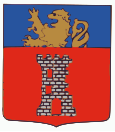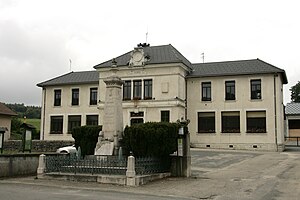Aranc
| Aranc | ||
|---|---|---|

|
|
|
| region | Auvergne-Rhône-Alpes | |
| Department | Ain | |
| Arrondissement | Belley | |
| Canton | Hauteville-Lompnes | |
| Community association | Haut-Bugey agglomeration | |
| Coordinates | 46 ° 0 ′ N , 5 ° 30 ′ E | |
| height | 431–1,011 m | |
| surface | 21.65 km 2 | |
| Residents | 326 (January 1, 2017) | |
| Population density | 15 inhabitants / km 2 | |
| Post Code | 01110 | |
| INSEE code | 01012 | |
| Website | www.aranc.info | |
 Aranc Municipal Council ( Mairie ) |
||
Aranc is a French municipality with 326 inhabitants (at January 1, 2017) in the department of Ain in the region Auvergne Rhône-Alpes . It belongs to the canton of Hauteville-Lompnes in the Arrondissement Belley and is a member of the Haut-Bugey Agglomération community association (until 2018: Plateau d'Hauteville ).
geography
Aranc is located at 775 m , about 13 kilometers east-northeast of the city of Ambérieu-en-Bugey and 31 kilometers southeast of the prefecture of Bourg-en-Bresse (as the crow flies). The small farming village extends in central Bugey , in a valley basin on the western edge of the Plateau d'Hauteville in the High Jura , at the northern foot of the Tré Pellay ridge .
The area of the 21.65 km² municipal area covers a section of the southern French Jura. The area lies almost exclusively on the Jura high plateau, which is characterized by several terrain structures running parallel in a north-south direction. In the central part is the Aranc basin, the northern section of which is occupied by a moorland. This is drained by the Grand Dard to the north to the Borrey (source brook des Oignin ).
To the east, the municipal area extends over several ridges (up to 940 m ) to the Col de la Berche. These mountain ranges rise to the south and reach the highest point of Aranc at 1011 m on the Tré Pellay . To the west of the Aranc basin is another ridge that drops steeply into the erosion valley of the Mandorne (right side stream of the Albarine ). The upper half of the mandorne catchment area is also part of the municipality of Aranc.
In addition to the actual village, Aranc also includes various hamlets and farms, namely:
- Rougemont ( 880 m ) at the height east of the Aranc basin
- Résinand ( 615 m ) in a saddle in the catchment area of the mandorne
- Les Pézières ( 590 m ) in the Mandorne Valley
Neighboring municipalities of Aranc are Corlier and Izenave in the north, Champdor-Corcelles with the Commune déléguée Corcelles and Plateau d'Hauteville with Hauteville-Lompnes in the east, Évosges in the south and Oncieu , Nivollet-Montgriffon and Boyeux-Saint-Jérôme in the west.
history
Aranc, which has been a parish since the 13th century, is mentioned for the first time under the name Arencus . The area had belonged to the Rougemont rulership since the 12th century, which was under the sovereignty of the Counts of Savoy. With the Treaty of Lyon , Aranc came to France in 1601.
Attractions
The village church of St. Paul was built in the 13th century in Gothic styles and redesigned in the 19th century. At Résinand there is a chapel that was built in the 19th century. On a hill north of Rougemont are the ruins of the 12th century Rougemont Castle.
population
| year | 1962 | 1968 | 1975 | 1982 | 1990 | 1999 | 2006 | 2016 |
| Residents | 329 | 296 | 269 | 273 | 291 | 275 | 285 | 326 |
With 326 inhabitants (January 1, 2017), Aranc is one of the small communities in the Ain department. After the population had decreased in the first half of the 20th century (737 people were counted in 1896), the population has remained at a relatively constant level since the beginning of the 1970s. The local residents of Aranc are called Randaoillard (e) s in French .
Economy and Infrastructure
Until well into the 20th century, Aranc was a village dominated by agriculture , especially dairy farming and cattle breeding. Even today, the residents live mainly from their work in the first sector. Outside the primary sector there are few jobs in the village.
The village is located away from the larger thoroughfares. The main access is from Corlier at the department of road D8 of Hauteville-Lompnes to Saint-Jean-le-Vieux . There are other road connections with Évosges and Oncieu.
Web links
literature
- Gérard Jacquet, Val d'Aranc, Rougemont, Vallée de la Mandorne: Inventaire Patrimoine 1990 (PDF, 3.4MB) on the website of the municipality of Aranc (French).
Individual evidence
- ↑ É. Philipon: Dictionnaire Topographique du Département de l'Ain . Imprimerie Nationale, 1911, p. 12 (French, online [PDF; accessed January 4, 2014]).
- ^ Aranc - notice communal. In: cassini.ehess.fr. Retrieved June 10, 2015 (French, INSEE population from 1968 ).


